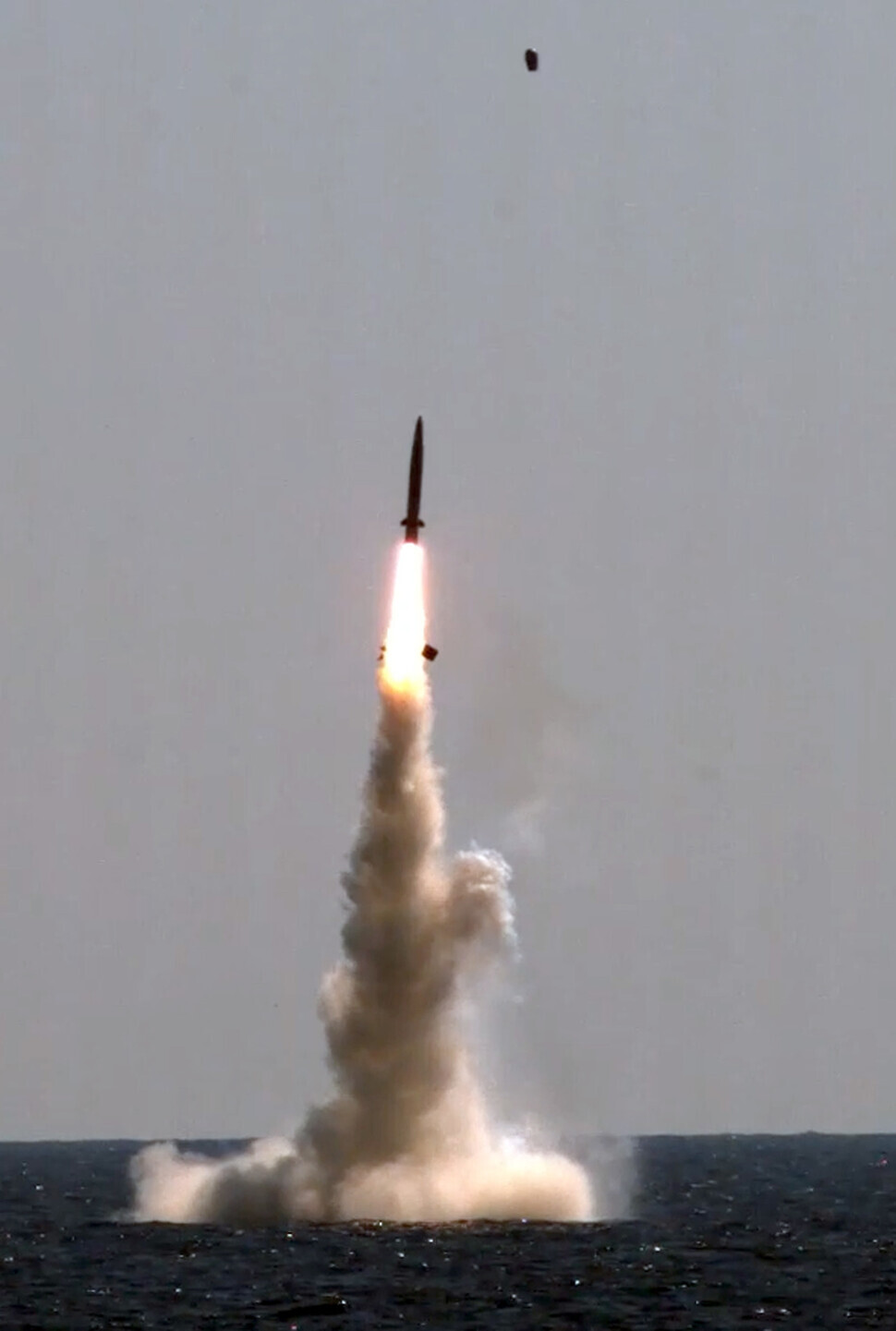hankyoreh
Links to other country sites 다른 나라 사이트 링크
S. Korea successfully tests domestically developed submarine-launched ballistic missile

South Korea succeeded in launching its own independently developed submarine-launched ballistic missile (SLBM) for the first time Wednesday.
The Agency for Defense Development (ADD) said Wednesday that it had “succeeded in test-launching a submarine-launched ballistic missile with President Moon Jae-in and others in attendance” at its Anheung Test Center in South Chungcheong Province earlier that day.
The agency explained that the missile had been launched underwater from a domestically produced 3,000-ton class Dosan Ahn Changho submarine, flying in a southward direction and hitting its target.
While the ADD had conducted several tests on land and in water tanks in the past, this marked its first success with a launch from an actual submarine. The missile is to go through additional testing and evaluation before being placed into combat position based on military integration plans.
An SLBM is a weapon capable of being launched at major facilities as the submarine covertly approaches in the waters near its adversary. It’s been called a “game changer” in warfare terms since it can be launched from watercraft with superior stealth and survival capabilities.
It also stands to impact the military balance in East Asia — which is why not only North Korea, but also China and Japan have reacted sensitively to South Korea developing the missile.
Moon said, “Increasing our missile firepower can offer a definite deterrent against North Korean provocations. With the success of this test, we have shown adequate deterrence.”
The Ministry of National Defense (MND) said that South Korea was the seventh country in the world to successfully launch an SLBM from a submarine. The six countries that are currently operating SLBMs are the US, Russia, China, the UK, France and India.
The ministry added that it did not include North Korea on the list of countries operating SLBMs, saying that while it has launched SLBMs from barges, it has not been confirmed that it has the capabilities to launch them from an underwater submarine.
The same day, the MND announced the successful tests of a ballistic missile carrying the world’s heaviest warhead; a long-range air-to-surface missile; and a supersonic cruise missile.
“The ballistic missile carrying the world’s largest warhead weight is capable of striking concrete buildings and underground tunnels,” the ministry said. “It can strike and neutralize major targets accurately and powerfully.”
The missiles would reportedly be used as key firepower to strike major North Korean facilities in the event of an emergency.
The South Korean Joint Chiefs of Staff (JCS) also announced the same day that North Korea had test-fired two short-range ballistic missiles from a central inland location toward the East Sea.
“At 1234 and 1239 hours today, we detected two short-range ballistic missiles fired toward the East Sea from the Yangdok area in South Pyongan Province,” the JCS said. The missiles flew for 800 kilometers (497 miles) at an altitude of roughly 60 kilometers (37.2 miles).
The latest missile launch came two days after North Korea’s announcement Monday that it had test-launched a new type of long-range cruise missile. The Blue House held a meeting of its National Security Council to discuss response plans presided over by National Security Office Director Suh Hoon.
Some observers suggested that North Korea’s decision to test ballistic missiles a few hours earlier was an attempt to push back against South Korea’s SLBM launch plans. But others stressed that SLBMs and ballistic missiles hold different military importance and strategic significance.
By Kwon Hyuk-chul, senior staff writer
Please direct questions or comments to [english@hani.co.kr]

Editorial・opinion
![[Guest essay] Amending the Constitution is Yoon’s key to leaving office in public’s good graces [Guest essay] Amending the Constitution is Yoon’s key to leaving office in public’s good graces](https://flexible.img.hani.co.kr/flexible/normal/500/300/imgdb/original/2024/0416/8917132552387962.jpg) [Guest essay] Amending the Constitution is Yoon’s key to leaving office in public’s good graces
[Guest essay] Amending the Constitution is Yoon’s key to leaving office in public’s good graces![[Editorial] 10 years on, lessons of Sewol tragedy must never be forgotten [Editorial] 10 years on, lessons of Sewol tragedy must never be forgotten](https://flexible.img.hani.co.kr/flexible/normal/500/300/imgdb/original/2024/0416/8317132536568958.jpg) [Editorial] 10 years on, lessons of Sewol tragedy must never be forgotten
[Editorial] 10 years on, lessons of Sewol tragedy must never be forgotten- [Column] A death blow to Korea’s prosecutor politics
- [Correspondent’s column] The US and the end of Japanese pacifism
- [Guest essay] How Korea turned its trainee doctors into monsters
- [Guest essay] As someone who helped forge Seoul-Moscow ties, their status today troubles me
- [Editorial] Koreans sent a loud and clear message to Yoon
- [Column] In Korea’s midterm elections, it’s time for accountability
- [Guest essay] At only 26, I’ve seen 4 wars in my home of Gaza
- [Column] Syngman Rhee’s bloody legacy in Jeju
Most viewed articles
- 1[Guest essay] How Korea turned its trainee doctors into monsters
- 2Korea ranks among 10 countries going backward on coal power, report shows
- 3[Editorial] 10 years on, lessons of Sewol tragedy must never be forgotten
- 4Faith in the power of memory: Why these teens carry yellow ribbons for Sewol
- 5[Guest essay] Amending the Constitution is Yoon’s key to leaving office in public’s good graces
- 6[Column] A death blow to Korea’s prosecutor politics
- 7[News analysis] Watershed augmentation of US-Japan alliance to put Korea’s diplomacy to the test
- 8‘National emergency’: Why Korean voters handed 192 seats to opposition parties
- 9[Photo] Cho Kuk and company march on prosecutors’ office for probe into first lady
- 10How Samsung’s promises of cutting-edge tech won US semiconductor grants on par with TSMC